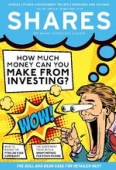Archived article
Please note that tax, investment, pension and ISA rules can change and the information and any views contained in this article may now be inaccurate.
Are investors getting fed up with share buybacks?

Having bought back a record $23.5bn of its own stock in the first three months of the year, US consumer electronics giant Apple has announced plans to extend its buyback programme by a further $100bn.
On this side of the Atlantic several high-profile buybacks have been unveiled recently including HSBC’s (HSBA) pledge to buy $2bn worth of its own stock, Aviva (AV.) launching its biggest repurchase of shares in a decade at £600m, and a £500m buyback at Paddy Power Betfair (PPB).
However, several of these recent announcements didn’t get a positive reaction by the market, and although in some cases this is because they were accompanied by other bad news, it does suggest investors could be getting disillusioned with this method of capital return.
COMPANIES ARE FLUSH WITH CASH
Companies are sitting on lots of cash, perhaps because they have adopted a more cautious manner since the financial crisis in 2017/2018.
US companies closed 2017 with cash worth more than $1.9tn according to Moody’s. Apple alone has a net cash pile of $163bn.
The latest figures for Europe, the Middle East and Africa, also from Moody’s and covering 2016, showed €974bn stashed on corporate balance sheets with the ratio of cash to revenue at a seven-year high.
In a potential negative sign, rather than investing more money in their own businesses, many companies are either returning this cash to shareholders or splurging on M&A.
HOW DO SHARE BUYBACKS WORK?
Buybacks, alongside ordinary and special dividends, are a method of giving cash back to investors. They involve a company buying their own stock with the aim of reducing the number of outstanding shares.
A share buyback can be more tax efficient for shareholders if you assume they would prefer to be taxed on a capital gain than the income from dividends.
Buybacks can also imply the management team of a company believe the shares are undervalued.
POOR JUDGES OF VALUE
Historically companies have been poor at judging if their shares are truly undervalued. For example, US management teams sanctioned the most ever buybacks in 2007 when the market peaked and ignored buybacks completely during 2008 and 2009 which was, in hindsight, the biggest buying opportunity in recent history.
In the worst examples, buybacks can be used to massage earnings per share with the aim of hitting management bonus targets. If you reduce the number of shares in issue, then even if earnings are flat then the level of earnings per share will go up.
BUYBACK FATIGUE
Given this background, it is probably no surprise some market fatigue has set in over buybacks. Back in February AJ Bell investment director Russ Mould reflected on a negative reaction to a €500m buyback at British Airways owner International Consolidated Airlines (IAG).
‘Share buybacks can be an acquired taste,’ he noted. ‘Yes, they quickly return cash to investors, who may be happier to receive the money than to see IAG invest it in fresh capacity across its routes at a time when consumer confidence is still pretty depressed, at least in the UK, owing to weak wage growth relative to inflation.
‘But buybacks tend to work best when a company has ample funds to take care of the operational liquidity and needs of its business, when the balance sheet is rock solid and the stock is selling at a material discount to the company’s intrinsic business value.’
Communication is paramount – an investor needs to know why a company is buying back shares and also why it has gone down this route rather than increasing the regular dividend or making a one-off payout.
In February this year Lloyds (LLOY) announced a £1bn buyback having a year earlier returned excess capital through a special dividend.
This was its explanation for the switch: ‘In prior years, the board has distributed surplus capital by means of a special dividend. The board’s current preference is to return surplus capital by way of a buyback programme given the amount of surplus capital (£1bn in 2017 versus £350m in 2016), the normalisation of ordinary dividends, our return to full private ownership and the flexibility that a buyback programme offers.’ In our view this doesn’t adequately spell out the reasons for the change.
Retailer Next (NXT) in contrast is exceptionally good at explaining how and when it decides to buy back shares. You can generally find this information in its financial results statements. (TS)
Important information:
These articles are provided by Shares magazine which is published by AJ Bell Media, a part of AJ Bell. Shares is not written by AJ Bell.
Shares is provided for your general information and use and is not a personal recommendation to invest. It is not intended to be relied upon by you in making or not making any investment decisions. The investments referred to in these articles will not be suitable for all investors. If in doubt please seek appropriate independent financial advice.
Investors acting on the information in these articles do so at their own risk and AJ Bell Media and its staff do not accept liability for losses suffered by investors as a result of their investment decisions.

 magazine
magazine









